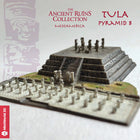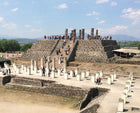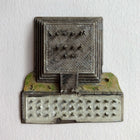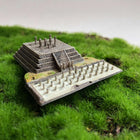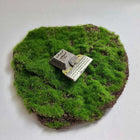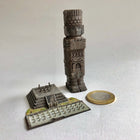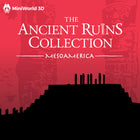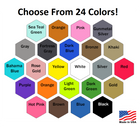Description
Tula (Pyramid of Quetzalcoatl) - Mexico Scaled 100% Accurate Model Miniature Tabletop Diorama Architecture
This comes in a SOLID color of your choice, the PLA Plastic material can easily be worked with if you'd like to hand paint details onto it. Pictures showing painted models are to show how a little paint can really bring these to life.
Comes in many colors and sizes! Fast shipping is guaranteed. This model is made from durable high strength plastic. If there is a color you'd like to see, or a color you'd like that isn't listed please feel free to inquire and we will get it done for you!
Welcome to Central Mexico!
The Ancient Ruins Collection - Mesoamerica presents: Tula
We continue The Ancient Ruins Collection--Mesoamerica, a dedicated subcollection to the legacy of past civilizations.
The Pyramid of Quetzalcoatl (labeled "Temple B" of the site by archeologists) is the main atraction in the ancient Toltec empire's capital of Tula, in central Mexico, just 75 km north of Mexico City.
This model contains:
- Actual state (ruins)
- Hypothetical reconstruction (based on the very similar, and better preserved temple of 1000 columns in Chichen-Itza)
- Statue of an Atlante (giant carved column)
Tula (Tollan in Nahuatl) is famous for the four columns carved in the shape of Toltec warriors, nicknamed "Atlantes". These remarkably well-preserved columns used to hold the roof of the temple on top of the Pyramid of Quetzalcoatl, of which nothing else remains.
At the base of the pyramid, there was a long, columned building now named "Burnt Palace" because there is evidence of its destruction in a fire. The use of big roofed spaces like this is unique in Mesoamerica.
Tula fell around 1150 AD, but it had significant influence in the following Aztec Empire, passing on much of the traditions, beliefs, and architectural style. The Aztecs considered themselves heirs of the Toltec greatness. The feathered serpent god Quetzalcoatl is linked to this city, whose worship was widespread from central Mexico to Central America at the time the Spanish arrived, in 1519.
The Mayan city of Chichen-Itza in far-away Yucatan has architecture that is strikingly reminiscent of Tula's, with a similar temple and columned palace; as well as decorative elements such as eagles eating hearts, and "tzompantlis" (skull mounds), very characteristic of Toltec culture but not of the Maya. There is no solid explanation for this correlation (from Wikipedia).
MiniWorld 3D is excited to bring this historical model to life as a homage to all the people of Mexico. This model was designed by founder Dany Sánchez, from scratch. Please give credit, it's all about spreading culture and education!
Be sure to follow them:
instagram.com/miniworld3d
instagram.com/ldibarra
MiniWorld 3D is a collective of 28+ artists creating the best library of 3D printable models of landmarks of the world!
Credit for model design and photos goes to MiniWorld3D
This model was designed by founder Dany Sánchez
Hand painted models in acrylics by Dany Sánchez.
Real location photo credit: Dany Sánchez.
Legal use under the Creative Commons - Attribution License
Free Shipping on all orders over $50
Materials: Plastic, LOVE.










